Classic French Toast isn’t just a breakfast favorite—it’s a nostalgic dish that speaks to comfort, warmth, and simple satisfaction. Whether you first tasted it at a family brunch or whipped it up on a lazy Sunday morning, this golden, custardy treat likely holds a place in your memory. And for good reason. With its crispy outside, soft center, and rich, eggy flavor, it’s one of those recipes that never really goes out of style.
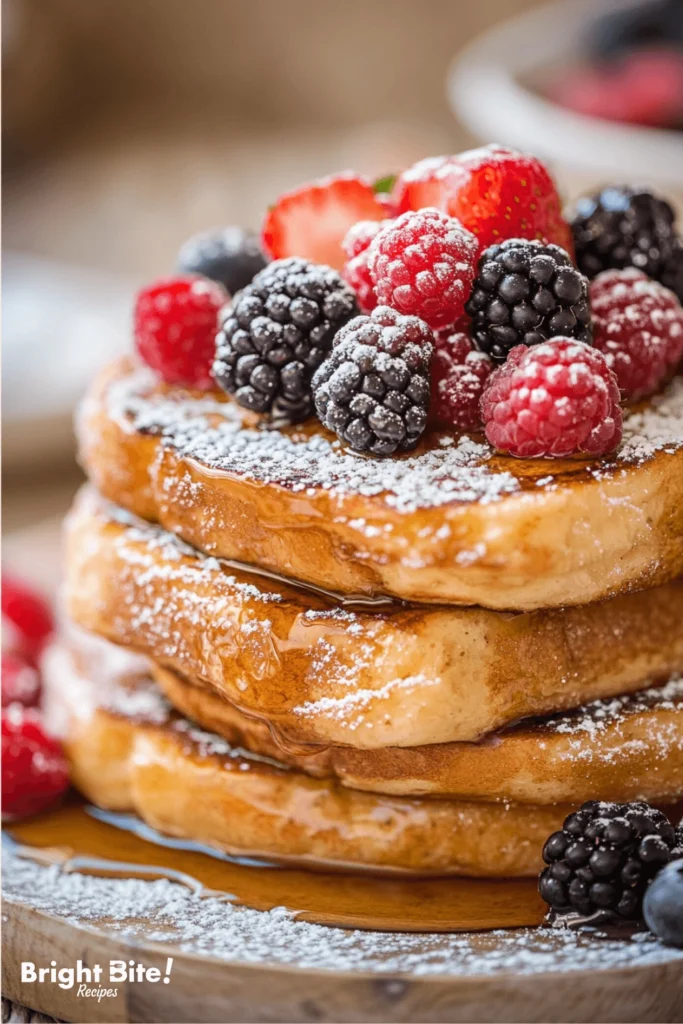
But here’s the thing—while it seems easy on the surface, great French toast isn’t just about dunking bread in eggs and tossing it on a pan. It’s about balance. It’s about choosing the right bread, using the right ratio of milk to egg, and knowing when to flip. Small details matter, and that’s where most recipes either shine or fall flat.
This article isn’t just going to tell you how to make Classic French Toast. It’s going to show you how to make the best version of it—whether you’re cooking for two or feeding a crowd. From insider tips and simple techniques to fun variations and perfect pairings, this is your go-to guide to mastering a true breakfast classic.
Table of Contents
Why You’ll Love This Recipe
There’s something universally appealing about Classic French Toast. It’s quick, it’s versatile, and it feels a little indulgent without being fussy. Here’s why this version might become your new favorite:
- Simple Ingredients – You likely have everything in your kitchen right now. No specialty shopping is needed.
- Customizable Flavors – Keep it traditional, or spice it up with cinnamon, nutmeg, or a splash of vanilla.
- Comfort Food Vibes – It’s warm, soft, and satisfying—perfect for slow mornings or breakfast-for-dinner nights.
- Kid and Adult Approved – Whether you’re cooking for picky eaters or brunch guests, this dish always wins.
Even better, once you get the technique down, you can play around with toppings and flavors to suit whatever mood or season you’re in.
Detailed Ingredients and Instructions
The heart of great Classic French Toast is its custard base. That creamy, eggy mixture is what gives the bread its signature texture—soft on the inside, crisp on the edges. But it’s more than just eggs and milk. Here’s what you need to know:

The Bread Matters
Let’s start here. Not all bread is created equal, especially when it comes to French toast. You want something thick enough to soak up custard but sturdy enough not to fall apart.
- Best Choices: Brioche, challah, or Texas toast.
- Pro Tip: Slightly stale bread works best. It absorbs more custard without becoming soggy.
The Custard Ratio
This is where a lot of people go wrong. Too much egg, and it’s rubbery. Too much milk, and it’s soggy. Aim for a balance that gives you a smooth, rich dip without going overboard.
A good rule of thumb: For every 2 slices of bread, use 1 egg and about a quarter cup of milk. You can scale up from there depending on how many you’re making.
Flavor Add-Ins
Classic French Toast doesn’t have to be plain. A little flavor goes a long way.
- Vanilla extract: Adds warmth and depth
- Cinnamon: Brings a cozy vibe
- Salt: Just a pinch to balance the sweetness
- Sugar or maple syrup (in the custard): Optional, but a small amount can enhance flavor
Cooking Technique
Once your bread is soaked (not drenched—just a few seconds per side), you want to cook it on medium heat. If the pan’s too hot, the outside burns before the inside cooks through. If it’s too cool, it never gets that golden crust.
Use butter or a combo of butter and oil for the best browning.
- Preheat your pan.
- Add a pat of butter.
- Lay the soaked slices in carefully.
- Cook for 2 to 3 minutes per side until golden.
And don’t overcrowd the pan—give each slice space to crisp up properly.
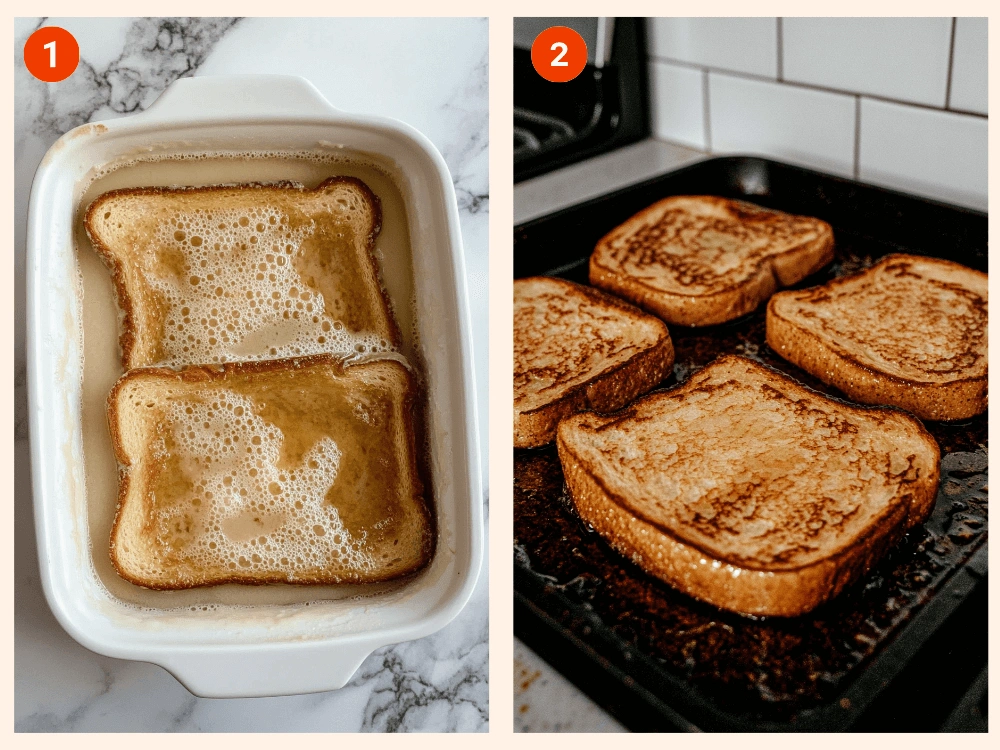
Final Touch
Before serving, let the toast rest for a minute on a wire rack. It keeps the bottom from steaming and turning soggy while you prep toppings.
Tips, Variations, and Storage Options
Once you’ve nailed the basic Classic French Toast recipe, you can start experimenting. Little changes in spices, toppings, or techniques can transform it into something fresh and new. Here’s how to get creative without complicating the process.
Tips for Success
- Don’t rush the soak: Give the bread time to absorb the custard—but not so long it falls apart. About ten seconds per side is usually enough.
- Wipe the pan between batches: If you’re making a big batch, clean off any burnt bits and add fresh butter before each round. This keeps every slice evenly golden.
- Use room-temperature eggs and milk: It helps the custard mix more smoothly and soak into the bread better.
- Keep it warm: If you’re making multiple servings, place finished slices on a baking rack in a low oven (around 200°F). It keeps them crisp and warm without drying them out.
Easy Variations
Just a few swaps or additions can totally change the vibe of your French toast.
- Stuffed French Toast: Spread cream cheese and fruit jam between two slices before dipping. Cook gently to avoid the filling oozing out.
- Savory French Toast: Skip the sugar and vanilla, and instead add herbs, parmesan, or even garlic powder to the custard. Top with avocado or a poached egg.
- Dairy-Free Version: Use almond, oat, or coconut milk, and opt for plant-based butter or oil for frying.
- Vegan Twist: Sub in a custard made with plant milk and cornstarch or a banana blend. It won’t be quite the same, but it still works.
Storage and Make-Ahead Tips
- Leftovers: Store cooked French toast in an airtight container in the fridge for up to three days. Reheat in a toaster oven or skillet to revive the texture.
- Freezing: Let slices cool, then freeze on a baking sheet. Once frozen, transfer to a zip-top bag. Reheat straight from frozen in the toaster or oven.
- Custard Prep: You can whisk together the custard a day in advance and store it in the fridge. Just stir it quickly before using it.
Equipment Needed
You don’t need a lot of fancy gear to make Classic French Toast, but having the right tools makes it easier to get the results you want.
- Nonstick or cast-iron skillet: Gives the toast an even, golden crust without sticking.
- Shallow baking dish or pie plate: Perfect for dipping bread into the custard.
- Whisk: Essential for blending eggs and milk into a smooth, even mix.
- Spatula: A wide, flat one makes flipping toast easier and neater.
- Wire rack: Helps keep the bottom crisp as the toast cools or waits to be served.
Optional but nice to have: a griddle if you’re cooking for a crowd or a sifter for dusting powdered sugar on top.
Related Recipes
If you’re into Classic French Toast, chances are you’ll love these other breakfast favorites. Here are a few worth trying:
- Buttermilk Pancakes – Fluffy, tender, and slightly tangy. A solid go-to for weekend brunches.
- Belgian Waffles – Crisp on the outside, light on the inside, and perfect for holding syrup.
- Cinnamon Roll Overnight Oats – A no-cook option that’s packed with cozy flavor and makes mornings way easier.
- Eggs Benedict – For when you’re feeling fancy. Poached eggs, toasted English muffins, and creamy hollandaise sauce.
- ChatGPT said:
- Cracker Barrel Pancakes – Light, tender pancakes with that classic homestyle flavor. Just like the ones from your favorite country kitchen, made for stacking high and drizzling with syrup. Ideal for slow mornings or breakfast-for-dinner nights.
All of these bring the same comfort-food energy but give you variety depending on how much time or effort you want to put in.
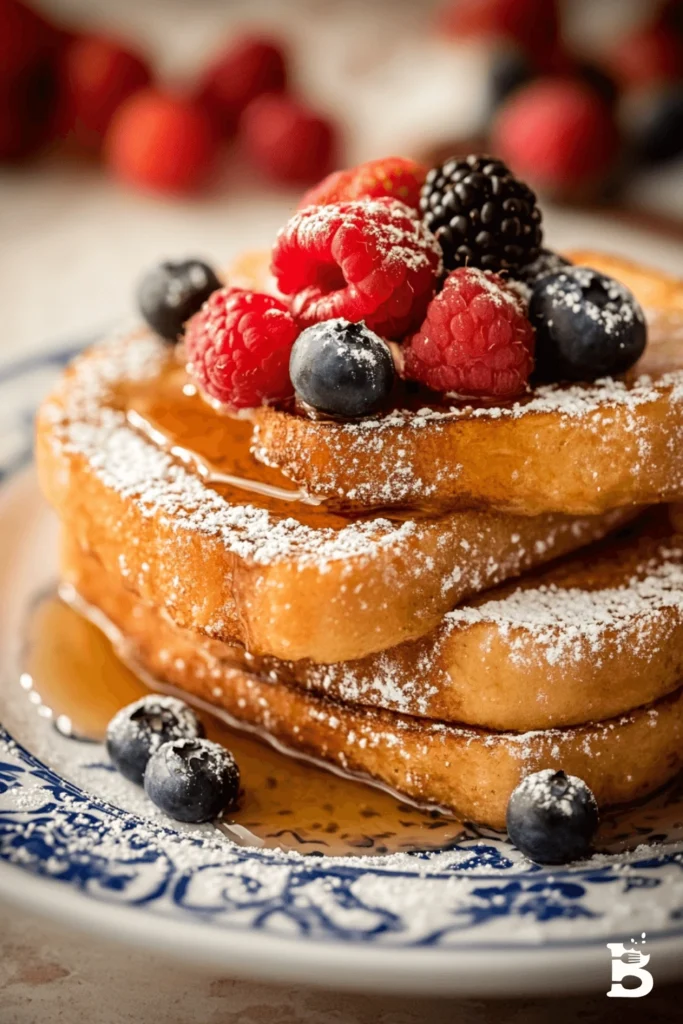
Pairing/Serving Suggestions
Classic French Toast is a solid main, but the sides, toppings, and drinks you serve it with can really round things out. Here’s how to build a full breakfast or brunch around it.
Topping Ideas
- Syrup: Maple is the classic, but honey or agave works too.
- Fresh Fruit: Berries, sliced bananas, or sautéed apples.
- Powdered Sugar: A quick dusting adds visual appeal and a touch of sweetness.
- Whipped Cream or Yogurt: Adds creaminess and contrast.
- Nut Butter or Chocolate Spread: For extra richness.
Savory Sides
- Crispy Bacon or Sausage: Brings balance and crunch.
- Scrambled Eggs: Keep it simple to avoid overpowering the toast.
- Avocado Slices: For something lighter but still filling.
Drinks That Work Well
- Coffee or Espresso: Obvious choice for good reason.
- Fresh-squeezed orange Juice: Brightens the meal and cuts the richness.
- Smoothies: A fruit-based one pairs well and adds color to your plate.
Think of your plate as a small, well-composed menu—something sweet, something savory, something fresh.
Frequently Asked Questions
Even with a recipe as familiar as Classic French Toast, a few common questions pop up—especially when trying to get that perfect texture and flavor. Here’s a quick FAQ to help troubleshoot and clarify.
Why is my French toast soggy?
The most likely reason is using too much milk in the custard or soaking the bread too long. Also, avoid thin sandwich bread—it can’t hold up. Go with thicker slices like brioche or challah, and dip them just long enough to absorb the custard without getting waterlogged.
Can I make French toast ahead of time?
Yes. Cooked slices can be cooled, stored, and reheated later. If you’re prepping for a crowd, you can also soak the bread and arrange it on a tray to cook fresh in the morning. Just don’t let it sit soaked for too long—overnight soaking is only okay if you’re baking it as a casserole.
What’s the best milk to use?
Whole milk gives the richest flavor, but any milk works. For a dairy-free version, almond, oat, or coconut milk are all good options. Just keep the ratio consistent.
Is it okay to use fresh bread?
Technically, yes, but slightly stale bread is better. It soaks up the custard without falling apart. If all you have is fresh, you can lightly toast it first to dry it out.
Can I bake instead of pan-fry?
Definitely, arrange soaked slices on a parchment-lined baking sheet and bake at 375°F for about 15 minutes, flipping halfway through. It’s not as crisp, but it’s a great option for batch cooking.
Why does my French toast taste eggy?
That’s a sign of too much egg in the custard or not enough flavoring. Add vanilla, cinnamon, and a pinch of salt to balance it out. Also, make sure the eggs are well whisked and fully mixed into the milk for a smoother consistency.
Nutrition Information
Here’s a basic breakdown of what you’re getting in a standard serving of Classic French Toast (two slices made with whole milk and white bread, pan-fried in butter):
- Calories: About 300
- Protein: Around 10 grams
- Carbohydrates: Roughly 35 grams
- Fat: About 12 grams (including saturated fat from eggs and butter)
- Sugar: Approximately 6 grams (can vary based on toppings)
Keep in mind that toppings like syrup, powdered sugar, or whipped cream can significantly increase both the sugar and calorie counts. If you’re looking for a lighter version, opt for fresh fruit and go easy on the syrup.
For those watching macros or dietary restrictions, it’s easy to tweak the recipe. Use low-fat milk, egg whites only, or nonstick spray instead of butter to shave off some fat and calories. Just know that small changes in ingredients can affect flavor and texture.
Seasonal and Occasion Variations
One of the best parts about Classic French Toast is that it adapts beautifully to the season or occasion. A few minor tweaks can give it a whole new vibe, whether it’s Christmas morning or a summer brunch.
Spring and Summer Versions
- Berry French Toast: Top with fresh strawberries, blueberries, and a drizzle of honey.
- Citrus Zest: Add lemon or orange zest to the custard for a bright, refreshing twist.
- Tropical Style: Use coconut milk and top with grilled pineapple or mango.
Fall Favorites
- Pumpkin Spice French Toast: Mix canned pumpkin and pumpkin pie spice into the custard.
- Apple Cinnamon: Add sautéed apples and cinnamon sugar as a topping.
- Maple Walnut: Toasted walnuts and maple syrup give a warm, nutty flavor perfect for crisp mornings.
Winter and Holidays
- Eggnog French Toast: Swap in eggnog for milk during December. Bonus if it’s homemade.
- Gingerbread Version: Add ground ginger, cloves, and molasses to the mix.
- Holiday Brunch Boards: Cut toast into triangles and serve with festive toppings like cranberry compote or spiced whipped cream.
Special Occasions
- Birthday Breakfast: Serve with sprinkles, whipped cream, and maybe a candle.
- Mother’s Day or Father’s Day: Pair with mimosas or a fancy coffee and serve on a nice tray.
- Valentine’s Day: Cut into heart shapes and top with strawberries and chocolate drizzle.
There’s no reason to stick with the same version year-round. This is one of those base recipes that lets you go traditional or totally over-the-top, depending on what the day calls for.
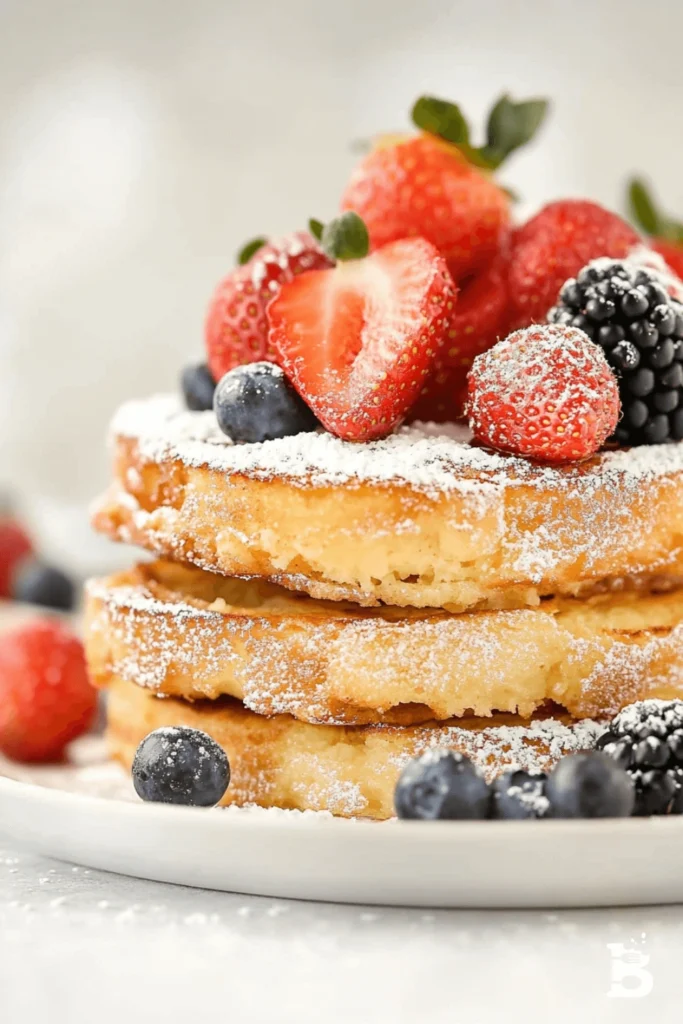
My Recipe Tips
Over the years, I’ve made Classic French Toast a hundred different ways. These are the tips that consistently give the best results:
- Please don’t skimp on the egg: That’s what gives the toast its structure. Milk adds creaminess, but eggs do the heavy lifting.
- Rest the bread briefly after cooking: One minute on a wire rack keeps it from going limp while still staying warm.
- Balance the flavors: Even in a sweet dish, a pinch of salt is crucial. It enhances all the other flavors and keeps things from tasting flat.
- Use good bread: It’s worth repeating—day-old brioche or challah makes all the difference. Don’t settle for thin slices of store-brand white bread.
- Fry in butter, not oil: Butter browns beautifully and adds flavor. Just keep the heat controlled to avoid burning.
Conclusion
There’s a reason Classic French Toast has been a breakfast staple for generations—it’s simple, comforting, and endlessly adaptable. Whether you’re throwing together a quick morning meal or hosting a cozy brunch, it fits the vibe. No fancy ingredients. No complicated methods. Just good food made right.
It’s also the kind of dish that improves with a little practice. The more you make it, the better you get at recognizing the ideal soak time, the perfect level of heat, and how to adjust flavors to suit the moment. Once you have mastered the base, the door opens to dozens of variations. Sweet, savory, seasonal, or indulgent—it all starts from this basic recipe.
So, if you’re looking for a dependable go-to breakfast that feels like a treat but comes together fast, this is it. Classic French Toast delivers every time.
Don’t be afraid to experiment. Try it with different breads. Play with flavors. Use it as a platform for creativity, or keep it ultra-traditional. Either way, it’s hard to go wrong when you start with something this timeless.
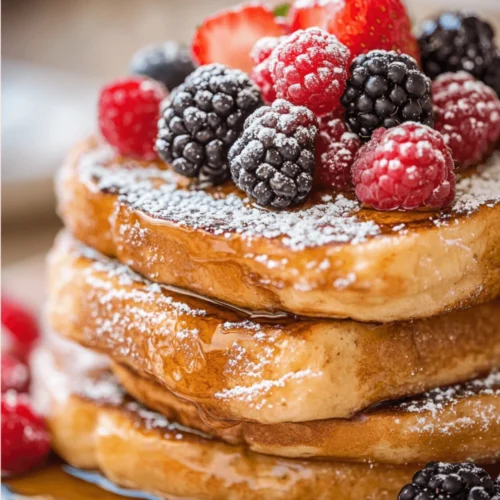
🍞 Classic French Toast 🍯🍴
Ingredients
- 4 slices of thick bread like brioche, challah, or Texas toast
- 2 large eggs
- 1/2 cup milk whole or 2%
- 1 teaspoon vanilla extract
- 1/2 teaspoon ground cinnamon
- 1/4 teaspoon salt
- 1 tablespoon butter for frying
- Maple syrup for serving
- Powdered sugar optional, for dusting
- Fresh fruit optional, for garnish
Instructions
- Prepare the egg mixture: In a shallow bowl or dish, whisk together the eggs, milk, vanilla extract, cinnamon, and salt until well combined.
- Dip the bread: Heat a skillet or griddle over medium heat. While it’s heating, dip each slice of bread into the egg mixture, ensuring both sides are coated. Let the excess liquid drip off before placing the bread in the skillet.
- Cook the French toast: Melt 1 tablespoon of butter in the skillet. Place the dipped bread slices in the skillet and cook for 2-3 minutes on each side, until golden brown and crispy. You may need to adjust the heat to prevent burning.
- Serve: Once the French toast is cooked, serve it immediately with maple syrup, powdered sugar, and fresh fruit, if desired.
